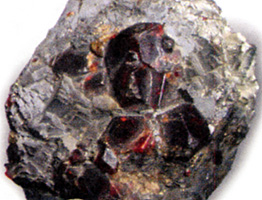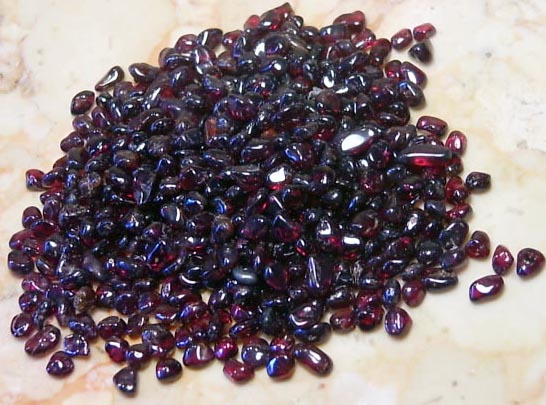GARNET



 Characteristics of the mineral.
Characteristics of the mineral.
In the jewelry business, the most widely used fire-red pyropes, crimson and sizo-red almandines and emerald green andradites (demantoids). In nature there are grenades in crystals of the whole range of colors, except blue. Silicate of magnesium and iron, is a valuable group. A variety of olivine, has many other names depending on the color: pyrope (red, dark scarlet), almandine (red with a lilac shade, most common in inexpensive ornaments and beads), hessonite (orange, honey to violet, often set in gold and Silver), spessartine (honey-yellow, orange-red, does not like the sun), uvarovite (a bright green emerald color brush of small crystals, the greenest mineral), grossular (green tones, similar to an emerald that is harder), demantoid (chrysolite) , The most sparkling green mineral), a hydrogranate (bluish), rhodolite (pink gharanat), melanite (black), topolite (yellow), sherlomite (black), etc.
Dark red garnet crystals in the rock resemble the fruit of a Phoenician apple - a pomegranate. Hence the name of the stone (latum granum - grain, grain). Surprisingly, the fact is: the garnet-mineral is unusually rich in natural facets. The outer faceting of minerals is a direct expression of their internal structure. It is believed that the currently accepted term garnet was introduced in 1270 by the medieval alchemist Albert Magnus. Since 1803, this term has been applied to a whole group of minerals, which include almandine, grossular, demantoid, chrysolite, pyrope, spessartine and uvarovite. Grenades are also considered to be red-brown andraits, named after the Portuguese mineralogist d'Andrade (1763-1838), who described them in 1800. Usually in the narrow sense of the grenades only transparent red stones-almandines and pyropes-are understood. Therefore, discussing the merits of pomegranates, you need to more accurately determine what kind of stone it is. Color pyrope is determined by ions of chromium and iron, almandines - ions of iron and manganese, spessartine - ions of manganese. Carbuncle is a red January color gem, a blood-red version of pomegranate (pyrope), an outdated and not used today name.
 Spessartine - a fairly common mineral pegmatites, but its jewelry varieties are rare. Most often find highly fractured, translucent crystals, unsuitable for jewelry purposes. Process spessartiny in accordance with the quality, color and transparency of the source material. When diagnosed, it is most often confused with hessonite. Only one of the varieties of spessartin is of interest: espressantite containing the almandine component. The cost of spessartins in the US is quite high. Beauty spessartinov determined by their color: orange, red-orange, yellow-brown. The dimensions of spessartine crystals of jewelry quality are insignificant.
Spessartine - a fairly common mineral pegmatites, but its jewelry varieties are rare. Most often find highly fractured, translucent crystals, unsuitable for jewelry purposes. Process spessartiny in accordance with the quality, color and transparency of the source material. When diagnosed, it is most often confused with hessonite. Only one of the varieties of spessartin is of interest: espressantite containing the almandine component. The cost of spessartins in the US is quite high. Beauty spessartinov determined by their color: orange, red-orange, yellow-brown. The dimensions of spessartine crystals of jewelry quality are insignificant.
Garnets are very popular and popular jewelry stones. Grenades are found in nature often, but samples of good quality are rare. Often garnets form perfect crystals in the form of rhombododecahedrons, tetra-gonotroctahedra or their combinations. Grenades are classified by species.
Magic properties of stones.
This stone is considered a symbol of heart feelings, love and friendship, it is also called a stone of honesty. He is a talisman of lovers, he is presented as a sign of friendship, memory and love. A pomegranate is a stone of love, which is able to arouse love passions and amuse the soul. He drives away sadness and brings joy to the owner.
According to other sources, the main magic property of a grenade is its ability to give birth to strong passions and desires that can become dangerous and turn against the owner. On the arm of a man possessed by passion, they begin to shine brightly, as they are filled with blood. Talisman of a wise and kind heart. Talisman of travelers. It is believed that red grenades excite sexuality, evoke a sense of courage, stimulate will and endurance, and also contribute to the development of self-esteem. The pomegranate and the mascot of warriors, keeping them in battles and making them valiant and honest in battle. A stone does not support a person who possesses "espionage" qualities, especially if it does not matter who cares. The pomegranate despises the greedy, but does not prevent them from accumulating, but it can get lost. The stone is very exacting to those who do not want to take responsibility for themselves. Indiscriminate people grenades are useless.
People believe that the ring with a grenade gives its owner the power over people. The pomegranate is the mascot of transformers and reformers spiritually aspiring, for it possesses celestial purity, and from there draws, from an inexhaustible mine, its energy gifts. Their favorite owners are guaranteed from the leakage of energy, happiness and prosperity. If a person is very passionate, then the garnet gets even more color saturation and affects others. Green garnet gives the owner the gift of foresight. The mascot of the family, garnet builds relationships even with distant relatives, and makes children obedient. Grenades are also considered symbols of faithfulness, faith, devotion and power. Grenades of black color can contribute to communication with the world of the dead. They are also useful for those who want to look into the future.
Almandin - red-violet (purple) grade of pomegranate. This is the hardest and one of the most common varieties of pomegranates. Greater hardness from almandines differ only similar in color rubies. Almost black almandines are rare. Makes their surroundings more harmonious. Very good for teenagers, especially girls. They are good at carrying beads from the almandine - it will help to make a choice where to go to study. This stone can be worn by everyone, it is connected with travel. Travel, fearlessness and courage. It has long been considered a stone of entertainment, balls, masquerades. This stone can make a person's whole life a continuous holiday. It is especially easy to use it to harmonize the surrounding real-world situation.
The pie is a red garnet. Very interesting stone, which brings happiness only to passionate people, active, with a huge emotional impact, investing themselves in a whole deal. Therefore, to people inert, unemotional, lazy, it brings only misfortunes and it can not be worn in this case. It can only be used on dynamics, only in practice. This stone is only in the dynamics of tension. He will help you to keep this energy. Long wearing a pomegranate on the arm makes the fearless person emotionally agitated and the garnet in this case fades. A "poured" it only on the hand of a very passionate person - the grenade reacts to his condition.
Hessonite - a kind of pomegranate honey-yellow or orange color. From afar the orange color of the hessonite can be perceived as red. Hessonite is lower in quality and value than other grenades. The color of the hessonite resembles a mineral hyacinth - a reddish-brown variety of zircon. This is the stone of the active defender of the weak, the stone of the prosecutor or the lawyer, the stone of the champion of justice. If you are sure of your right, wear hessonite. This is one of the few stones that is almost not contraindicated to anyone. This stone is a universal conciliator.

Poisonous and radioactive dangerous stones and minerals
** - poisonous stones and minerals (mandatory check in the chemical laboratory + explicit indication of toxicity).
** - radioactive stones and minerals (mandatory check on the standard dosimeter + ban on open sales in the case of radioactivity over 24 milli / g / h + additional measures of population protection).
All rare stones are subject to mandatory inspection at the standard dosimeter for the permissible level of radiation and in the chemical laboratory for the absence of poisonous and evaporating components that are dangerous to humans and the environment.


Comments
When commenting on, remember that the content and tone of your message can hurt the feelings of real people, show respect and tolerance to your interlocutors even if you do not share their opinion, your behavior in the conditions of freedom of expression and anonymity provided by the Internet, changes Not only virtual, but also the real world. All comments are hidden from the index, spam is controlled.